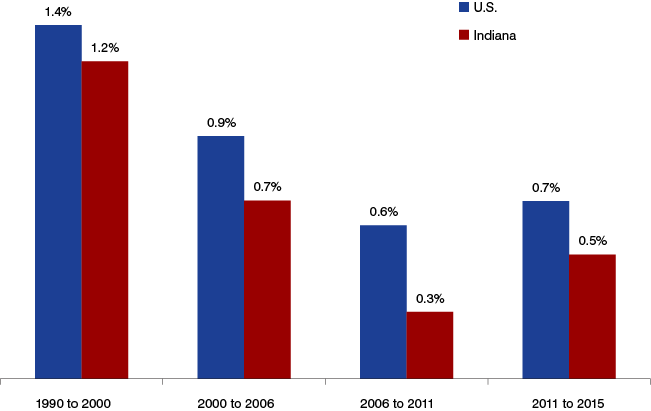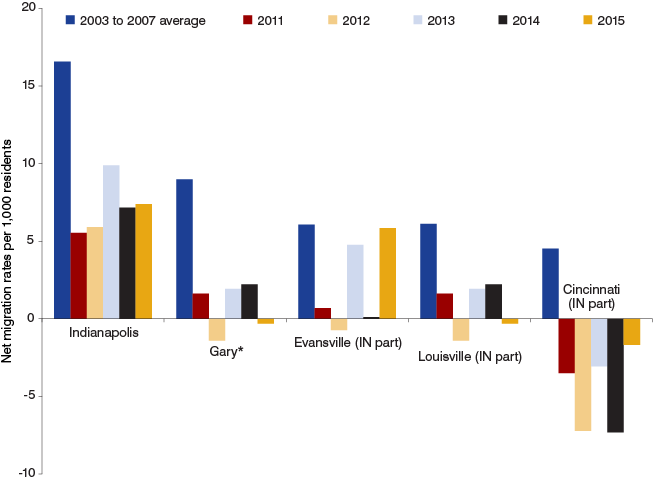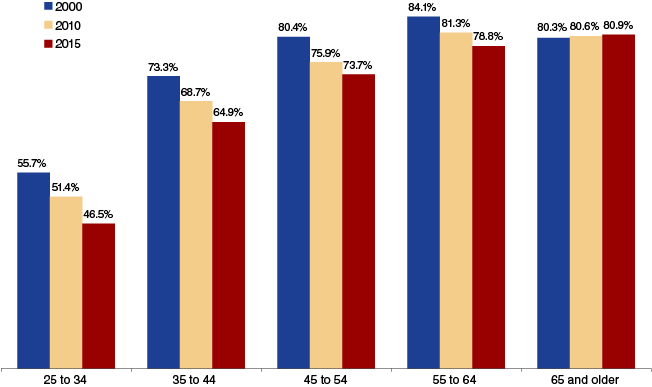Demographic drivers of Indiana housing market continue to lag

Indiana’s housing market has improved, even though key demographic drivers remain stuck in second gear.
By most measures, the Indiana housing market continues to show sustained improvement. Through the first half of 2016, for instance, growth in existing home sales and residential building permits has outpaced the nation (see Table 1). Meanwhile, prices for existing homes in the state are up by more than 6 percent over their pre-recession peak, and Indiana’s foreclosure rate is at its lowest point since 2000.
Table 1: Indiana housing market by the numbers
| Indicator | U.S. | Indiana |
|---|---|---|
| Existing home sales between July 2015 and June 2016 (year-over-year change) | 5.1% | 6.7% |
| House price appreciation, 2015 Q2 to 2016 Q2 | 5.6% | 5.1% |
| Residential building permits issued between July 2015 and June 2016 (year-over-year change) | 3.1% | 7.4% |
| Foreclosure rate, 2016 Q2 | 1.6% | 1.8% |
| Months supply of inventory, June 2016 | 4.6 | 4.9 |
| Rental vacancy rate, 2016 Q2 | 6.7% | 10.0% |
Source: IBRC, using data from the Indiana Association of Realtors, National Association of Realtors, Federal Housing Finance Agency, U.S. Census Bureau and Mortgage Bankers Association
Much of this progress has occurred despite the fact that the key demographic drivers of the state’s housing market remain stuck in second gear. This article examines the demographic forces that typically help to shape the housing market, including household formation rates, migration and generational shifts in the population.
Household formation shows modest improvement
Annual population growth in Indiana remains low. The state added 21,800 residents in 2015—its second-smallest annual gain since 1989. Over the past four years, Indiana has grown by an average of nearly 26,000 people a year, which is less than half the average annual gain during the 1990s (53,600 per year) and still well below the average mark set during the 2000s (40,300).
One bright spot in the population numbers is that some important age groups—from the perspective of the housing market—are showing growth. Indiana’s population between the ages of 25 and 44, for instance, grew by roughly 1,700 in 2015. This is a fairly modest number, but it is the third consecutive year that this young-adult group has grown after declining for at least 12 years previously. This age group, which is typically responsible for net gains in new households and home purchases, will continue to grow as the comparatively large millennial generation comes of age.
Given the state’s sluggish population growth, it is little wonder that household formation rates have slowed too. In the wake of the housing slump, Indiana was adding new households at an anemic 0.3 percent per year. This measure has improved slightly in recent years with the state’s average annual household formation rate up to 0.5 percent between 2011 and 2015 (see Figure 1). Stated in raw numbers: Indiana added more households in the last four years (48,000) than it did over the five years between 2006 and 2011 (31,800).
Figure 1: Average annual household formation rates

Note: This chart shows the average annual rate during each time frame.
Source: U.S. Census Bureau (decennial census and American Community Survey)
Household formation rates are driven by two factors: so-called headship rates (i.e., the number of households divided by the adult population) and the level of migration to the state. With regard to headship rates, the negative effects of the Great Recession caused many young adults to delay forming a new household, while some older adults were forced to leave their homes and reside with family or friends. This increased “doubling up” has led to a decline in headship rates in nearly all age groups in Indiana. In 2007, for instance, approximately 50 percent of Hoosiers between the ages of 25 and 34 were the head of their own household, but the headship rate for this age group had dropped to 45 percent by 2015.
Table 2 provides estimates of the shortfall in the number of households in Indiana caused by the decline in headship rates. The shortfalls were calculated by looking at the differences in the actual number of households in 2015 compared to the number of households we would expect if age-specific headship rates were still at the levels seen before the recession hit in 2007. The decline in the headship rate for the 25-to-34 age group referenced earlier translates to 41,000 fewer households in the state within this group alone. This number accounts for nearly half of the state’s total estimated shortfall. All told, Indiana would have had 84,000 more households in 2015 if headship rates were still at 2007 levels.
Table 2: Estimated shortfall in number of Indiana households in 2015
| Age group | Headship rate, 2007 | Headship rate, 2015 | Actual number of households in 2015 (thousands) | Number at 2007 headship rates (thousands) | Difference (thousands) |
|---|---|---|---|---|---|
| 15 to 24 | 14.5% | 12.5% | 117.6 | 135.7 | -18.1 |
| 25 to 34 | 49.8% | 44.7% | 380.5 | 421.5 | -41.0 |
| 35 to 44 | 54.5% | 51.6% | 424.9 | 446.4 | -21.5 |
| 45 to 54 | 57.4% | 55.8% | 490.5 | 502.0 | -11.5 |
| 55 to 64 | 58.3% | 57.9% | 495.1 | 496.5 | -1.4 |
| 65+ | 62.1% | 62.8% | 606.4 | 597.1 | 9.3 |
| Total | 48.9% | 47.3% | 2,515.1 | 2,599.2 | -84.0 |
Note: Columns may not sum due to rounding.
Source: IBRC, using U.S. Census Bureau American Community Survey data
This shortfall should represent a pool of currently pent-up housing demand that could enter the market in the coming years. While Indiana’s headship rates may not get back to 2007 levels, the state should see a rebound in this measure over the next few years if it is anything like the rest of the nation. An analysis from the Urban Institute indicates that the U.S. headship rate should improve by roughly 1.5 percentage points between 2013 and 2020.1 This increase reflects both the effect of an aging population and more young adults starting households as the labor market improves.
The other pillar of new household formations—net in-migration—continues to be lackluster as well. After posting a net in-migration of residents over the previous two years, the U.S. Census Bureau estimates that Indiana had a net outflow of about 2,300 residents in 2015.
The migration slowdown is proving to be one of the most durable side effects of the Great Recession. Even as the economy improves and home sales trend up, the movement of new households into the state, or even to a neighboring county within Indiana, remains low by pre-recession standards. This slowdown is most evident in many traditionally fast-growing suburban areas.
Figure 2 compares the annual net migration rates over the last five years for the suburban counties of several metro areas in the state against their average annual levels before the recession. The 10 suburban counties of the Indianapolis metro area averaged an annual net in-migration rate of nearly 17 migrants per 1,000 residents between 2003 and 2007, but the average annual inflow so far this decade is well below half of this pre-recession level. For the suburban counties in the Gary Metropolitan Division (i.e., Porter, Jasper and Newton counties), the average annual migration rate so far this decade is just one-tenth of the mark set between 2003 and 2007. Migration is also down in Indiana’s suburban counties in the Louisville and Cincinnati metros, although Warrick County is leading a bit of a revival in the Indiana portion of the Evansville area.
Figure 2: Comparison of net migration estimates for Indiana’s suburban counties in select metro areas

* The Gary Metropolitan Division is the Indiana portion of the larger Chicago-Naperville-Elgin metro area.
Source: U.S. Census Bureau population estimates
Homeownership rate stabilizes
If new households begin to form at a greater rate, will they be looking to buy or rent? If recent trends hold, more will be looking to the rental market than was the case before the housing slump. Indiana’s homeownership rate peaked at 72.1 percent in 2006, and then plunged more than 3 percentage points to 68.5 percent by 2013. With falling foreclosure rates and strong buyer demand in recent years, the state homeownership rate appears to have held steady since 2013, with no statistically significant changes in this measure over the last two years.
While the homeownership rate holding firm in 2015 is certainly welcome news, the focus on the overall homeownership rate tends to distract attention from even larger shifts in most age–specific rates. Over the past fifteen years, for instance, Indiana’s total homeownership rate was down 3.3 percentage points, but the homeownership rates for Indiana’s 25-to-34 and 35-to-44 age groups have declined by 9 percentage points and 8 percentage points over the same period, respectively (see Figure 3). The state’s 45-to-54 age group didn’t fare much better, declining nearly 7 percentage points between 2000 and 2015. Only Indiana’s senior age group has seen its homeownership rate on the rise.
Figure 3: Indiana homeownership rates by age

Source: U.S. Census Bureau (decennial census and American Community Survey)
The comparatively small change in the overall homeownership rate is simply a function of the fact that the Indiana population is growing older and the likelihood of being a homeowner increases with age. With the baby boom generation now between the ages of 52 and 70, this age group holds a larger share of the state’s population than ever before. This is also the prime age group for homeownership. Thus, the continued aging of this outsized cohort will boost the state’s total homeownership rate, even if age-specific rates only hold constant going forward.
Conclusion
The good news is that Indiana’s household formation rate is starting to improve, and the state’s homeownership rate appears to be stabilizing. The coming of age of the relatively large millennial generation should also boost housing demand, but until we start to see sustained improvements in migration and overall population growth, the contributions from the demographic drivers of the housing market will be muted.
Of course, these demographic factors ultimately rely on a strong economy, and in this area there is some reason for optimism. As of September 2016, the state had added 44,300 jobs in the last year, and its unemployment rate was down to 4.5 percent. Meanwhile, the Census Bureau reports that the state’s real median household income increased in 2015 and is at its highest point since 2007. If the economy can continue to build steam, the effects will hopefully begin to boost the demographic drivers of the housing market.
Notes
- Laurie Goodman, Rolf Pendall and Jun Zhu, “Headship and Homeownership: What Does the Future Hold?” The Urban Institute, June 2015, www.urban.org/research/publication/headship-and-homeownership-what-does-future-hold.
